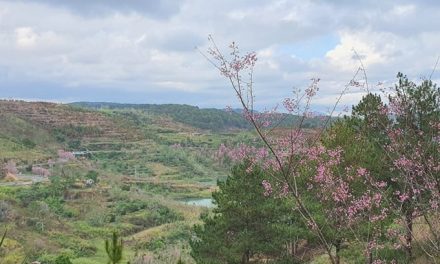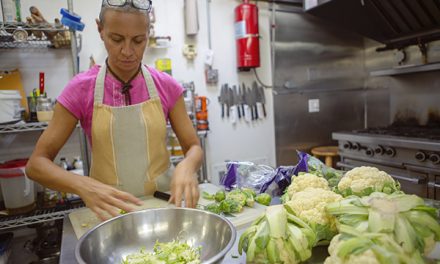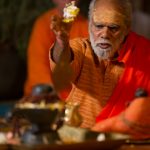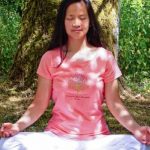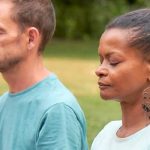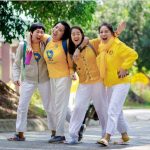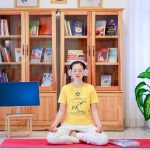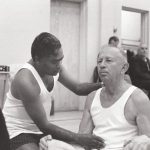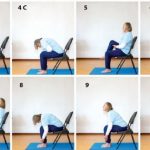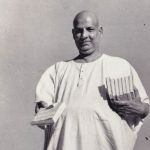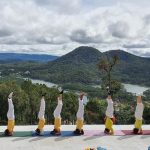Yoga Teachers’ Training Course Goes to Prison
Prison Yoga Outreach Project – Sivananda TTC Enlightens Inmates at Otisville Federal Corrections Institute
By John Ittner
“A robber robs for getting freedom from want – though his movement may be crooked and long-winded. Every movement of your foot is toward freedom or Sat-chit-ananda.” – Swami Sivananda, Bliss Divine
Everybody wants to be free. “Freedom is man’s birthright”, says Swami Sivananda. But what about the millions of men and women who are in prison, can they be free while behind bars? Yoga says they can and The Sivananda Prison Outreach programme is proving it with the first ever Teachers’ Training Course given in prison. The drive from the Sivananda Yoga Ranch Ashram to The Federal Correctional Institute, Otisville, New York, takes about half an hour and passes through the lush forest-covered hills of the southern Catskills.
Mahadev Chaitanya now makes the trip once a week, arriving there at 7am. His mission is to bring yoga to the prisoners and he recently took me with him to visit the Institute. Mahadev Chaitanya, who runs the day-to-day operations at the Yoga Ranch, and Srinivasan, the long-time Yoga Ranch director, are showing the inmates at Otisville prison how to follow a straight path to freedom. The course they are following is the same as the one designed by Swami Vishnudevananda and taught to all Sivananda teachers.
They are learning Hatha Yoga, philosophy, anatomy, meditation theory and practice, chanting, mantras, Bhagavad Gita and nutrition. There is one difference. Instead of the one month of intensive study between start and graduation, it will take the inmates about eight months to complete the course. At the time of my visit they were already six months into the course and it showed. They had the shiny look about them that comes from practising Yoga. This programme did not materialise like magic out of thin air.
It all began in 1996 with a letter from an inmate to Prison Life magazine, who had a copy of Swami Vishnudevananda’s Complete Illustrated Book of Yoga. His letter of appreciation was so influential that hundreds of other inmates were inspired to write to the Sivananda organisation asking for books. They were taking a step in the direction of freedom. Intuition told them that Yoga offered a path that people behind bars could take, a way to set the spirit free while incarcerated.
It’s like the verse in Johnny Cash’s “Grey Stone Chapel” from his Folsom Prison concert album. “Behind the walls of prison my body may be / but my Lord has set my soul free.”
The spiritual path has always been there for prisoners and Yoga is another expression of it. The Sivananda Prison Outreach Project has continued and grown over the years. In the first six months of last year about $3,000 was raised at the Yoga Ranch and 200 books were sent out to prisons all around the country. During this time classes have been taught at two prisons. The next step was for the inmates to become their own teachers.
In February 2015 a proposal to teach the Teachers’ Training Course was presented to Otisville Federal Correction Institute and was accepted, and soon after the classes began. The rationale outlined in the proposal was powerful, and it can now be a model for other prisons and ashrams to state their cases for similar yoga programmes. It says: “With 2.3 million prisoners, the U.S. has the highest incarceration rate in the world. When wellness and education programmes aiding rehabilitation are very limited, sharing Yoga teachings proves to be a very interesting and low-cost alternative…
The inmates develop an awareness of the body; enhanced sensitivity toward themselves and empathy toward others, leading to compassion and in turn to prevention of violence.” There is an interesting story to this that demonstrates the power of Yoga to generate empathy. Mahadev Chaitanya says that one of the early problems with the Teachers’ Training at Otisville was the tendency for the inmates to always choose the same partners when they broke into groups for teaching practice. Prisoners tend to stick with their group and not mix generally.
Sex offenders were shunned in the TTC at first as is the case in the prison population at large. Inmates did not want to mix. Mahadev Chaitanya gently encouraged them to treat each other the same but initially this did not work . This type of behaviour does not change easily because the underlying judgments are strongly held. But after only a few days, inmates came to him and apologised. From then on there was no problem. This was a big change and I was really surprised when he told me the outcome. Of course I should have known better.
Yoga is very powerful. If you took away the gleaming coils of razor wire and the high chain-link fences that surround it, Otisville prison would look like a community college with low brick buildings arranged in a campus-like setting. Built in 1977, it is called a medium security institution and it is considered a good place to be if you have to be locked up. The fact that F.C.I. Otisville is open to having Sivananda Teachers’ Training shows that it takes the role of rehabilitation seriously and is not merely a place to separate convicts from the rest of society.
We arrived a little after 7am on a Thursday and went to the reception area. At first I was not allowed to enter because I was wearing grey sweat pants which happened to be the same colour as the inmates’ uniform. There was a sign stating that visitors are forbidden to dress like the inmates, but the problem was easily solved when I was given a pair of white yoga pants which I changed into in the bathroom. Getting into prison was harder than I thought it would be! We were allowed to pass through some big, heavy duty steel doors.
When they shut behind us they made a sound suggesting something very gloomy like, “abandon all hope, ye who enter here.” About a dozen inmate TTC students arrived for satsang looking sharp and sattvic in their yellow T-shirts and fresh white yoga pants. If you did not know they were convicted felons, you would not guess it. They say that clothes make the man and these prisoners proved the point They not only looked like yogis in their TTC uniforms, they acted like yogis.
Seeing them reminded me of the opening ceremony at my own Teachers’ Training at the Sivananda Ashram in Neyyar Dam, south India, in 2000. We let go of our egos and joined one another in a quest to find our true Self. The uniform removed some of the differences between us and began the process. The yellow and white had power to unite us and reminded us that we were all in it together. The prisoners looked really good in their uniforms. I don’t know what I was expecting, but I was surprised.
They were really fit as physical culture is huge in prison and most of them looked as if they lifted weights. They were a lot more muscular than most yogis and many of them were tattooed. To a man they looked tough, but they were not at all intimidating. This was the only all male TTC I had ever seen. They were older, and more mature looking but generally did not appear to be hardened, quite the contrary. Their faces were open, eager, serious and grateful. I saw some of the highest wattage smiles that I can remember ever seeing.
I did not expect that either. Mahadev Chaitanya had gone ahead of me while I was changing and when I entered the gym where the classes took place, he had already set up the altar with portraits of Swami Sivananda and Swami Vishnudevananda. He and I sat in front on either side of the altar and the inmates were in two rows facing us. Mahadev Chaitanya took the microphone and with his gentle, unassuming directness greeted the class and thanked them for coming. I could see that they could relate to him.
He talked about the TTC graduation in October and said that Srinivasan would be coming to teach them more about the Bhagavad Gita and Vedanta to prepare them for the final test. He passed the microphone to me and I introduced myself and told them that I was here so that I could write about this ground-breaking prison programme. I couldn’t help but say how yogic they all appeared, how impressed I was by their great accomplishment, how it showed in their faces and in the respect they had for the teaching.
They had clearly absorbed the spirit of yoga like sponges absorbed water and were clearly eager to learn. I passed the microphone back to Mahadev Chaitanya who began to chant Om and we all joined in. We meditated for about 20 minutes in silence except for the loud humming of fans, the clanking of the weight-lifting machines from a nearby room and the occasional, incomprehensible (to me at least) announcement over the PA system. A couple of times I opened my eyes a tiny bit to see how they were sitting.
They were sitting very still with eyes closed, straight backs, relaxed faces and full concentration as far as I could tell. After the meditation we chanted Jaya Ganesha which is the same whether it is sung in an ashram or in a prison. When I was passed the microphone, I chanted Vande Gurudev. Then Mahadev Chaitanya asked if anyone else wanted to lead a chant. At first there were no takers, but soon a long-haired inmate, who introduced himself as “Dog”, came up and sang one of my favourites, written in English by Swami Sivananda.
“Serve. Love. Give. Purify. Meditate. Realize. Be good. Do good. Be kind. Be compassionate. Inquire who am I. Know thyself and be free. You will soon attain immortality.” Dog had a great smile and a nice voice for this song of freedom. We broke into four groups and migrated to the corners of the gym. My group was taught by an enthusiastic and serious inmate named Cliff who really knew his stuff. It was hard to imagine him ever committing a felony. That was true of most of the inmates, but especially him. His face was unmarked.
He looked young and focused. He could have been teaching at any Sivananda Centre, or Ashram, and you would think, “Wow, this guy is good.” His tone was very relaxing and I soon forgot I was in prison. My awareness was focused on the postures, and another kind of freedom showed itself to me in Otisville. Then it was over and it was time to go. Mahadev Chaitanya and I passed through the heavy doors on our way out. They slammed shut behind us with the same heavy sound as when we entered. Lucky us, we could leave. But I knew the answer to the question I had asked. The answer was “yes” there is freedom in prison and Yoga shows the way.
Mahadev Chaitanya is manager of the Sivananda Yoga Ranch and teaches in the TTC and ATTC worldwide. email: sivanandayogaranch.org

